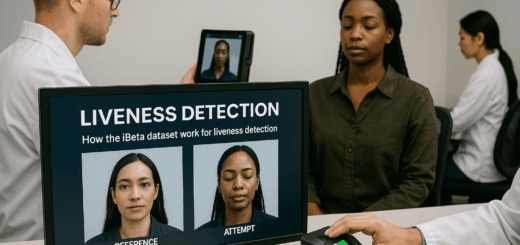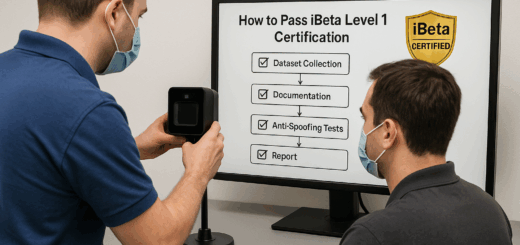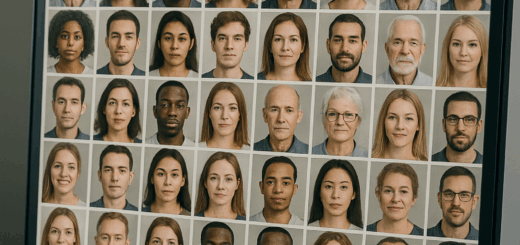How to Pass iBeta Certification? A Step-by-Step Guide
Obtaining iBeta certification is a significant milestone for any company developing biometric authentication solutions. It demonstrates compliance with ISO/IEC 30107-3 Presentation Attack Detection (PAD) standards, boosts credibility in the global marketplace, and provides assurance to regulators, clients, and end-users that the system is resistant to spoofing and fraud.
But how can an organization prepare, optimize, and actually pass iBeta certification? Let’s break it down into actionable steps.

1. Understand iBeta Certification Requirements
Before pursuing certification, companies must clearly understand what iBeta tests:
- ISO/IEC 30107-3 compliance (global PAD standard)
- Level 1 and Level 2 PAD testing, which simulate simple and advanced spoof attacks
- Performance metrics including:
- FAR (False Accept Rate)
- FRR (False Reject Rate)
- SFAR (Spoof False Accept Rate)
- FAR (False Accept Rate)
- Repeatability: The biometric system must consistently resist spoofing attempts under controlled lab conditions.
✅ Tip: Study the PAD framework carefully and align your internal testing with ISO/IEC 30107-3 well before submitting your solution.
2. Prepare Your Biometric Solution
Passing iBeta certification requires more than just raw accuracy in recognizing users — the system must show robust liveness detection.
2.1 Optimize Liveness Detection
- Use multi-factor signals: skin texture, depth, motion cues, temperature, pulse.
- Add anti-spoof algorithms trained on diverse attacks (e.g., paper photos, silicone masks, video replays, 3D-printed faces).
- Incorporate AI-driven liveness that adapts to emerging threats.
2.2 Reduce False Rejects
- Balance security vs usability: overly strict systems may reject genuine users.
- Test across diverse demographics to minimize bias.
2.3 Control Environmental Factors
- Ensure performance in various conditions (lighting, backgrounds, noise).
- Account for different hardware (smartphones, tablets, cameras, sensors).
3. Conduct Internal Pre-Testing
Never go into iBeta certification blind. Companies that pass usually run internal dry runs first:
- Simulate Level 1 attacks (printed faces, basic masks, video replays).
- Simulate Level 2 attacks (3D masks, silicone or latex models, higher-budget spoofs).
- Measure acceptance and rejection rates internally before submitting.
- Run stress tests across devices, operating systems, and conditions.
This stage helps identify weak points that iBeta might exploit in official testing.
4. Engage with iBeta Early
iBeta operates as an independent accredited lab, but companies can often:
- Consult about scope: clarify whether you are applying for FIDO certification, Android biometric certification, or general ISO/IEC 30107-3 PAD certification.
- Plan test coverage: decide if both Level 1 and Level 2 certification are required.
- Align timelines: certification can take several weeks depending on test complexity.
Being proactive avoids costly delays later.
5. Go Through the Official iBeta Testing Process
The iBeta certification process typically follows this structure:
- Submission of System
- Provide your biometric software, hardware, or SDK to iBeta.
- Supply documentation on its intended use, supported devices, and operating conditions.
- Provide your biometric software, hardware, or SDK to iBeta.
- Test Design & Setup
- iBeta selects volunteers and prepares spoof artifacts.
- The iBeta dataset is used for controlled testing (live vs spoof samples).
- iBeta selects volunteers and prepares spoof artifacts.
- PAD Evaluation
- Level 1: 150 spoof attempts + 50 genuine attempts (basic attacks).
- Level 2: Advanced spoofs with higher budget, more preparation, and skilled attackers.
- Level 1: 150 spoof attempts + 50 genuine attempts (basic attacks).
- Performance Metrics Report
- FAR, FRR, and SFAR results.
- Pass/fail determination (0% spoof penetration is required at Level 1).
- FAR, FRR, and SFAR results.
- Certification Issued
- Successful systems receive official recognition and can publicly state “iBeta PAD Certified.”
- Successful systems receive official recognition and can publicly state “iBeta PAD Certified.”
6. Common Reasons for Failing iBeta Certification
Even strong biometric systems can fail due to overlooked issues:
- Weak liveness detection against low-effort attacks (e.g., photo on a phone screen).
- High false reject rate causing frustration for real users.
- Device dependence (works on high-end phones but not mid-range).
- Limited demographic testing, leading to bias in accuracy.
- Inconsistent results across environments (low light, glare, varied backgrounds).
7. Best Practices to Pass on the First Attempt
- Design PAD early: integrate spoof resistance into the core algorithm, not as an afterthought.
- Test globally: include diverse demographics, ages, and skin tones.
- Focus on usability: balance strict security with smooth user experience.
- Stay updated: adapt to new spoofing methods like AI-generated deepfakes.
- Perform independent audits before official submission.
8. After Certification: Maintaining Compliance
Passing iBeta once isn’t the end — certification must be maintained and renewed:
- Re-testing: Many clients require vendors to stay compliant with annual or bi-annual re-tests.
- Continuous updates: Attack methods evolve, so liveness detection algorithms must improve over time.
- Expanding scope: New modalities (iris, voice, behavioral biometrics) may require fresh certifications.
9. Related Topics to Cover
- How to pass iBeta certification
- iBeta PAD certification process
- ISO/IEC 30107-3 testing steps
- iBeta Level 1 vs Level 2
- biometric spoof resistance testing
- liveness detection preparation
- FIDO biometric certification
- Android biometric certification iBeta
- biometric vendor certification tips
Conclusion
Passing iBeta certification is not only about meeting technical standards — it’s about proving to regulators, partners, and users that a biometric system is resilient, fair, and trustworthy. Success comes from early preparation, robust liveness detection, internal testing, and proactive engagement with iBeta.
Organizations that approach certification as an ongoing process — not just a one-time hurdle — will stand out as leaders in biometric security and gain a competitive advantage in regulated markets like finance, healthcare, and government services.
Systems must demonstrate strong resistance to spoofing and meet ISO/IEC 30107 PAD standards.
Companies should optimize their biometric algorithms, strengthen liveness detection, and run internal security tests.
Weak spoof resistance, poor liveness detection, and lack of compliance documentation are frequent reasons.
The timeline depends on system readiness, but most certifications take several weeks to a few months.
Yes, the process includes application, dataset testing, evaluation, and certification upon meeting requirements.


